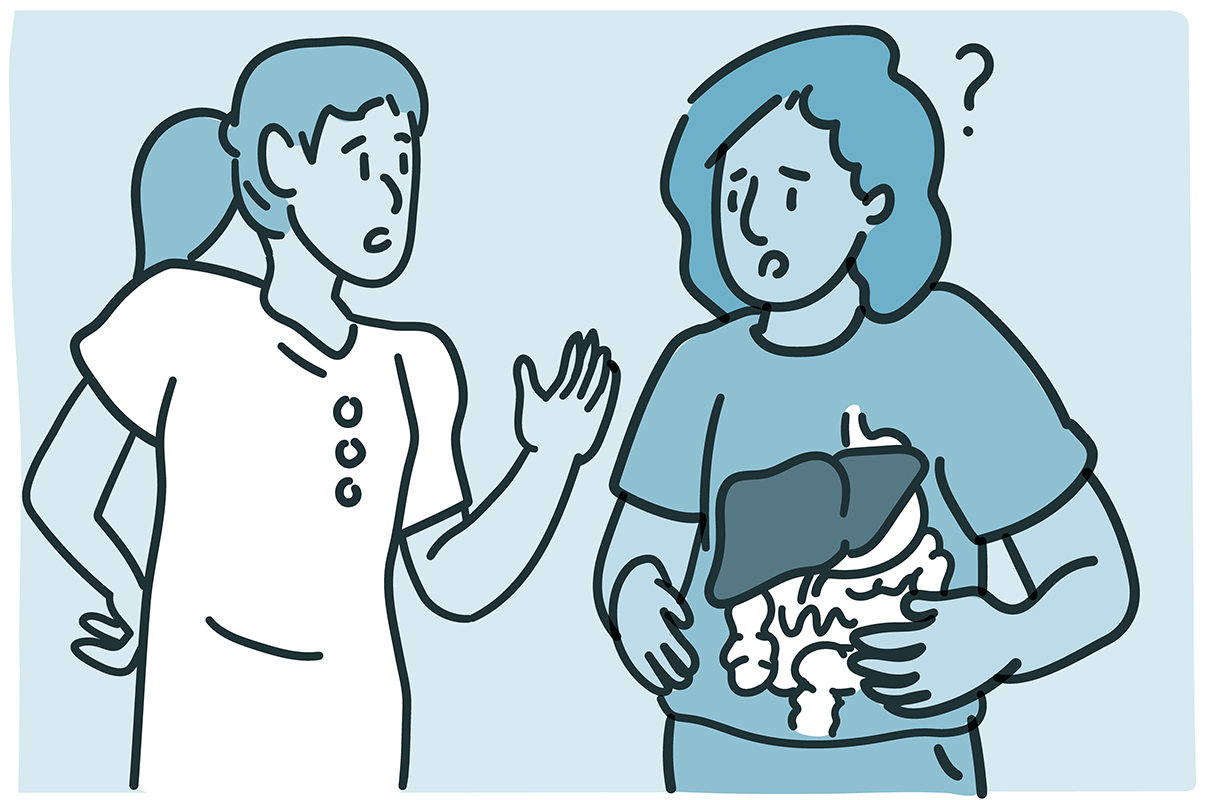Consider Your Liver
Here’s How it Protects Your Health

Your liver is one of the most important organs inside your body, and it’s also the largest. But do you know what it does or even where it’s located? One thing’s for sure: You can’t live without it. Your liver carries out hundreds of essential tasks every day.
The liver is a reddish-brown wedge-shaped organ about the size of a football. It sits just under your ribs against the right side of your stomach. Most people’s livers weigh about 3 pounds. But its size and weight can vary depending on your size.
“The liver is important for maintaining the health of the overall body, because it processes all the nutrients from the food that we eat. And it produces a lot of the proteins that the body needs to stay healthy,” says Dr. Marc Ghany, a liver researcher and clinician at NIH. “It also cleanses the body of toxins and breaks down substances that could be harmful to the body. And it stores most of the vitamins and minerals that we need to stay healthy.”
The liver clears away old red blood cells. It also makes substances that help your blood to clot.
The liver is tough and resilient. Unlike most other organs, the liver can regenerate and repair itself after an injury. It keeps working even under stress. But over time, damage can build up and cause problems.
The good news is you can take steps to keep your liver healthy. And many liver diseases can now be treated or even cured, thanks in large part to NIH-supported discoveries.
Spotting Liver Problems
There are many kinds of liver diseases and conditions. Unfortunately, many disorders go undetected for years because they don’t cause symptoms early on. About 4.5 million adults in the U.S. have been diagnosed with a liver disease. Many more may have one but don’t yet know it.
Some liver diseases are caused by viruses. Others can result from drug or alcohol misuse. Some people have inherited disorders that affect the liver. Some have too much fat in their liver. When liver problems are chronic (long-lasting), they can lead to cirrhosis, or severe scarring of the liver. Cirrhosis is considered a pre-cancerous condition. It can sometimes lead to liver cancer.
Warning signs of liver disease can include swelling of the abdomen and legs, changes in the color of urine or stool, or bruising easily. A yellowing of the skin or eyes, called jaundice, is another common sign of liver issues.
“But there may be no noticeable signs of disease until the liver has been severely damaged. And by then, it can be hard to treat,” says Dr. Arun Sanyal, a physician and liver expert at Virginia Commonwealth University. “That’s why it’s really important, even if you’re not having symptoms, to talk to your primary care doctor and ask about the health of your liver.”
If problems are caught early, you can take steps to protect your liver’s health (see the Wise Choices box).
Fat in the Liver
An increasingly common type of liver disease arises when too much fat builds up in the liver. This condition was known as nonalcoholic fatty liver disease. But experts changed the name in 2023 to “Having to do with metabolism, or the chemical changes in the body that create the energy and substances you need to grow, move, and stay healthy. metabolic dysfunction-associated steatotic liver disease.” Steatotic is a technical term for fat buildup in an organ. The new name highlights the links between fat in the liver and metabolic conditions, like diabetes and obesity.
“About 1 in 3 adults and maybe 1 in 5 adolescents in the United States has fatty liver, or steatotic liver disease,” says Dr. Norah Terrault, a physician and liver researcher at the University of Southern California. “This is a condition that can, in some instances, lead to scarring in the liver. It can even lead to cirrhosis and liver cancer.”
Having type 2 diabetes or obesity increases the risk for getting steatotic liver disease. Drinking too much alcohol can lead to a similar condition called alcohol-related liver disease. This condition also leads to fat buildup in the liver.
Until recently, there were no approved medications to treat metabolic dysfunction-associated steatotic liver disease. But just last year, the U.S. Food and Drug Administration approved the first drug to treat a severe form of the disease. The drug is called resmetirom (brand name Rezdiffra). Other potential treatment strategies continue to be developed and tested.
When Hepatitis Happens
The word “hepatitis” means Heat, swelling, and redness caused by the body’s protective response to injury or infection. inflammation or swelling of the liver. Most types of liver disease involve some sort of inflammation. Viruses, or viral hepatitis, is a leading cause of liver disease.
“Several different viruses can infect the liver. The main three that cause chronic liver infections are hepatitis B, hepatitis C, and hepatitis D,” Ghany says. These viruses usually spread through contact with an infected person’s blood or other body fluids.
Another virus, called hepatitis A, can cause a brief, mild illness. It often spreads by drinking or eating contaminated foods. Effective treatments and prevention strategies are available for all these conditions.
“Fortunately, we now have a curative therapy for hepatitis C. There’s an oral therapy that can cure more than 95% of people who are infected with the virus,” Ghany says.
Liver inflammation can also arise from exposure to toxic substances, too much alcohol, and certain drugs. For instance, the popular pain reliever acetaminophen, if taken improperly, can cause drug-induced liver injury. It’s a major cause of acute liver failure in the U.S.
“Acetaminophen is generally safe to take,” Ghany explains. “But some people may inadvertently take too much because they haven’t looked carefully at the product label.”
A combination of alcohol and acetaminophen can be especially harmful to the liver.
Preventing Problems
Since many liver diseases have no symptoms until they are very advanced, it’s important to get your liver checked at annual physical exams. Many problems can be detected by blood tests. “Be direct. Even if you have no symptoms, tell your doctor: I want my liver checked out,” Sanyal says. “It’s important that you feel free to ask questions of your doctor.”
“If you have a liver disease, we have many good treatments for most of these conditions,” Terrault adds. “With treatment, you can reverse or at least stabilize your liver and not end up with serious complications like cirrhosis and liver cancer.”
NIH Office of Communications and Public Liaison
Health and Science Publications Branch
Building 31, Room 5B52
Bethesda, MD 20892-2094
Contact Us:
nihnewsinhealth@od.nih.gov
Phone: 301-451-8224
Share Our Materials: Reprint our articles and illustrations in your own publication. Our material is not copyrighted. Please acknowledge NIH News in Health as the source and send us a copy.
For more consumer health news and information, visit health.nih.gov.
For wellness toolkits, visit www.nih.gov/wellnesstoolkits.




